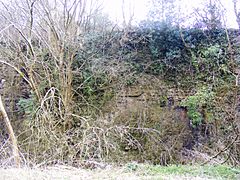Viaduct Quarry facts for kids
| Site of Special Scientific Interest | |
 |
|
| Area of Search | Somerset |
|---|---|
| Coordinates | 51°11′48″N 2°32′38″W / 51.19665°N 2.54378°W |
| Interest | Geological |
| Area | 0.3 hectares (0.0030 km2; 0.0012 sq mi) |
| Notification | 1984 |
Viaduct Quarry is a special place in Somerset, England. It's a 0.3 hectare area, which is about the size of a small sports field. This site is officially protected because of its important geology. It became a protected area in 1984.
What is Viaduct Quarry?
Viaduct Quarry is a Site of Special Scientific Interest (often called SSSI). This means it's a place that has been officially recognized as very important for its plants, animals, or geology. In this case, Viaduct Quarry is special because of its rocks and how they show us Earth's history.
It's a disused quarry, which means it's an old quarry that is no longer used to dig out rocks. Even though it's not active anymore, it's still a valuable spot for scientists.
Why is Viaduct Quarry Special?
Viaduct Quarry is a key site for something called the Geological Conservation Review. This review identifies and protects the best places in Britain to study geology. Think of it like a list of the most important outdoor classrooms for Earth science!
The quarry is famous for showing the best and thickest section of a rock type called the Downside Stone. This stone is a type of limestone. Limestone is a common rock that often forms from the remains of ancient sea creatures.
Millions of years ago, during the Lower Jurassic period, the area we now call the Mendip Hills was actually an island! The Downside Stone formed right next to this ancient Mendip Island. Studying the rocks at Viaduct Quarry helps scientists understand what the Earth was like in this area a very long time ago. It's like looking at a giant history book made of stone.

